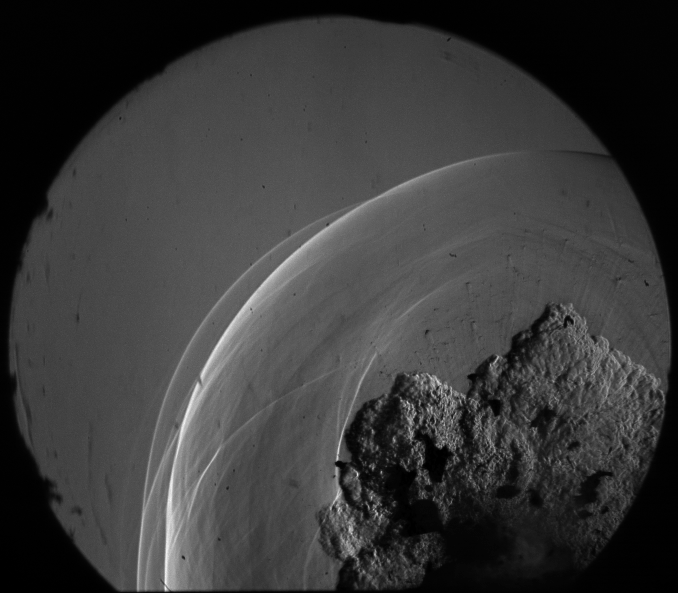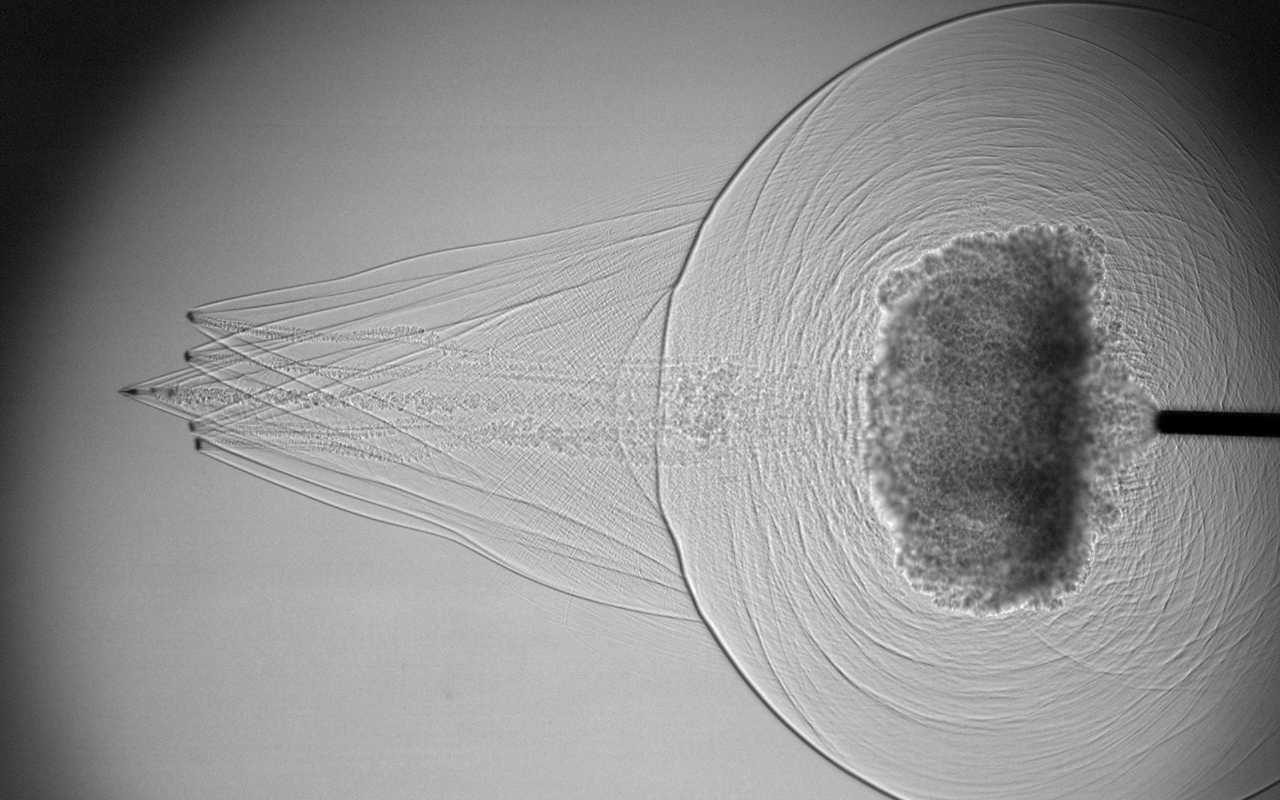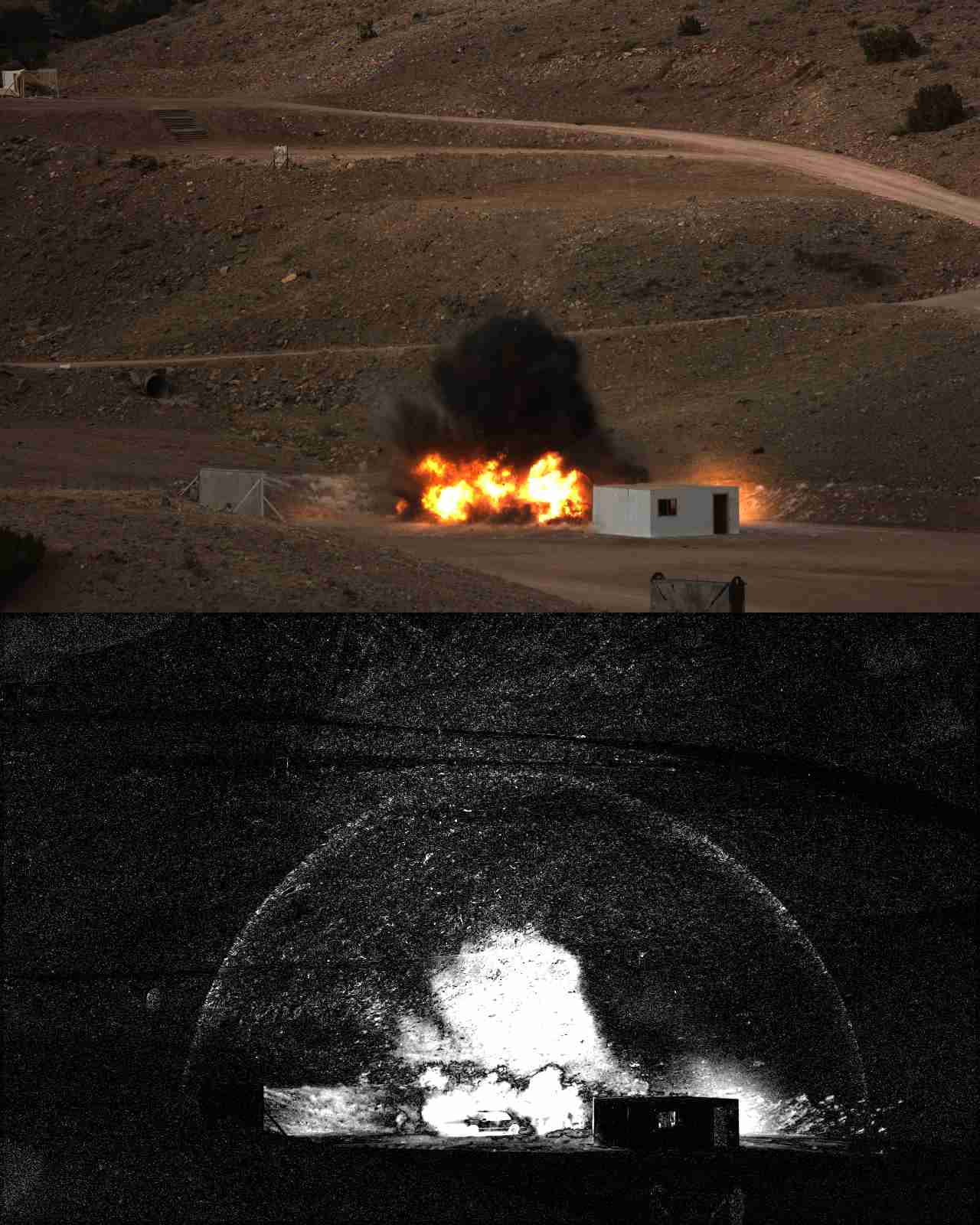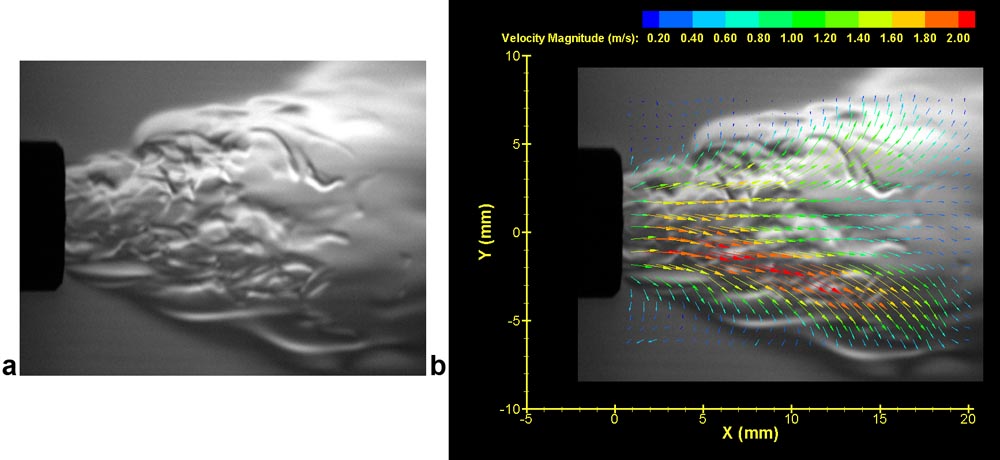Shock and Gas Dynamics Laboratory (SGDL)
The Shock and Gas Dynamics Laboratory performs research on thermal-fluid dynamics problems with specialites in optical diagnostics and explosively-driven flows. The research laboratory is supervised by Dr. Michael Hargather. The lab employs both graduate and undergraduate students, who work with Dr. Hargather on funded research projects.

The primary research interests of the SGDL include:
- Explosive characterization: shock wave propagation, product gas motion, fireball expansion, TNT equivalence, shape estimation
- Explosively-driven fragmentation: fragment size, velocity, shape distribution measurement, optical arena test characterizations, fragment aerodynamics
- Optical diagnostic development: 3D shock wave and fragment tracking, focusing schlieren, background oriented schlieren (BOS), high-speed imaging in harsh environments
- Rocket propulsion: 3D printing rocket motors, liquid rocket engine testing, flight testing
- General fluid dynamics and high-speed gas dynamics
The SGDL specializes in the application and development of optical diagnostics for studying refractive flowfields. Any flow with refractive index differences originating from temperature, pressure, density, or species gradients can be visualized and studied with these techniques. The general class of techniques was recently reviewed in a paper coauthored by Dr. Hargather.
 Schlieren imaging is the standard laboratory method for visualizing refractive index
gradients. The technique uses precision lenses or mirrors to create a region in which
refractive index gradients can be directly imaged. This technique produces images
which clearly show shock waves, expansion fans, turbulent gases, and small variations
in refractive index. A schlieren image of a small firework explosion is shown here,
with the shock wave and product gases produced clearly visible.
Schlieren imaging is the standard laboratory method for visualizing refractive index
gradients. The technique uses precision lenses or mirrors to create a region in which
refractive index gradients can be directly imaged. This technique produces images
which clearly show shock waves, expansion fans, turbulent gases, and small variations
in refractive index. A schlieren image of a small firework explosion is shown here,
with the shock wave and product gases produced clearly visible.

Retroreflective shadowgraphy is used to visualize the second-derivative of refractive index fields in the imaged area. This technique reveals sharp changes in refractive index, allowing visualization of shock waves and turbulent structures as well as contact surfaces. The image shown is of a sabot-launched rifle projectile, showing the oblique shock waves on the projectile and sabot pieces, circular muzzle blast, and product gas cloud. The retroreflective shadowgraph system was designed to be used outdoors and provides detailed visualizations at sizes in excess of 1m field of view in outdoor conditions.

The background oriented schlieren (BOS) technique is a digital method used to visualize refractive disturbances via their distortion of a background pattern. The technique is used here to visualize large-scale explosion phenomena like the car bomb shown. High-speed images of the explosion process are recorded, then processed using a range of digital image processing techniques to reveal locations where the background has apparently changed due to a refractive disturbance. The processing method here visualizes the shock wave from the explosion as well as fragments produced. The techniques is optically equivalent to schlieren and has a broad range of applications across the laboratory and field scales.

The optical techniques used by the SGDL can be applied in many unique methods to extract quantitative information from density fields, to object motions, to measurement of velocity fields. One example is the schlieren image velocimetry (SIV) technique which is used to measure velocity fields similar to the more conventional approach of particle image velocimetry (PIV). The SIV technique tracks "particles" that are the naturally-occurring refractive-turbulent eddies in the flow which are made visible through schlieren imaging. A sequence of schlieren images are recorded then image processing tracks the motion of the flow features to determine the local velocity fields. This technique works well for turbulent flows where density, temperature, or species gradients exist, as in compressible and combustion flows. By using the naturally-occurring refractive-turbulent eddies, we are able to obtain seedless velocimetry with SIV.

The SGDL laboratory space is located at the Energetic Materials Research and Testing Center (EMRTC), located adjacent to campus in Socorro, NM. The laboratory includes EMRTC Lab 4 and Lab 7, which are attached to the main EMRTC building. These labs are used for the development of optical techniques and small-scale explosive research. Additional laboratory space is also maintained on the EMRTC Field Lab for larger-scale explosive testing including, ballistic research, rocket testing, and free-air-blast research.
The EMRTC field lab includes over 40 square miles of space with more than 30 individual test sites to conduct explosive research and testing. The EMRTC is a part of New Mexico Tech and assists with all energetic testing in the SGDL.
The SGDL no longer actively employs students as Dr. Hargather is now an Adjunct Professor
Graduate students that have previously worked in the SGDL include:
- Maria Ortiz, graduate in June 2025 and accepted a job with the US Department of Defense. Maria's MS thesis title was Combined schlieren and imaging spectroscopy for multi-species flow field characterization and density reconstruction
- Maria D'Orazio, graduated in May 2025, is pursuing a PhD at Washington State University. Maria's MS thesis title was Plume identification and analysis using schlieren and background oriented schlieren
- Jessica Cooke, graduated in May 2025, is pursuing a PhD at Florida State University. Jessica's MS thesis title was Full-field density measurements in supersonic and explosively driven flows using quantitative schlieren
- David Avalos-Violante, graduated in August 2024, accepted a position at Sandia National Laboratories. David's MS Thesis title was Combustion performance and material characteristics of an ammonium perchlorate composite propellant (APCP) with varying aluminum particle size.
- Dr. Sivana Torres, graduated May 2024, accepted a position at Sandia National Laboratory. Sivana's PhD dissertation title was Quantification of polymethyl methacrylate (PMMA) shock, stress, and fracture response under explosive loading.
- Dr. Christian Peterson, graduated January 2024, accepted a position at Los Alamos National Laboratory. Christian's PhD Dissertation title was Characterization of the interface between detonation product gases and ambient air in an explosion.
- Kailene Strebe, graduated August 2023, accepted a position at Los Alamos National Laboratory. Kailene's MS thesis title was Quantitative background-oriented schlieren (BOS) measurements of explosives and high-speed projectiles using optical flow techniques.
- James Reeves, graduated May 2023, acceped a position at Naval Air Warfare Center China Lake. James's thesis title was Shock response spectra of shock loaded hemisphere and plate geometries.
- Dr. Stewart Youngblood, graduated in February 2023, accepted a position at Sandia National Laboratories. Stewart's PhD dissertation title was Fundamental study of fragmentation behavior and energy release of reactive materials.
- Simone Hill, graduated December 2022, accepted a position at Sandia National Laboratories. Simone's MS thesis title was Evolution of the flammability environment surrounding lithium ion batteries.
- Sean Palmer, graduated September 2022, acceped a position at Sandia National Laboratories. Sean's MS thesis title was Three-dimensional fragment tracking and size estimation using stereo focused shadowgraphy.
- Jason Falls, graduated February 2022, accepted a position at Lawrence Livermore National Laboratory. Jason's MS thesis title was High-speed quantitative schlieren measurement of density fields around conical supersonic projectiles
- Dr. Kyle Winter, graduated May 2021, accepted a postdoctoral job at Sandia National Laboratories. Kyle's PhD dissertation title was Irregular reflections of unsteady shock waves.
- Dr. Frank Austin Mier, graduated September 2020, accepted a postdoctoral job at the University of Wyoming. Austin's PhD dissertation title was Fluid dynamics of lithium ion battery venting failures.
- Julio Peguero, graduated September 2019, accepted a job at Sandia National Laboratories. Julio's MS thesis title was Measurement of shock and detonation propagation along pentaerythritol tetranitrate (PETN) thin films.
- Raj Bhakta, graduated October 2018, accepted a job at Sandia National Laboratories. Raj's MS thesis title was Development of a low-cost, multiple-diode, continuous laser for PIV applications
- Kyle Benalil, graduated September 2018, accepted a job with CORVID Technologies in Charlotte, NC. Kyle's MS thesis title was Three-dimensional reconstruction of turbulent gases using stereo schlieren and shadowgraph techniques.
- Rudy Morales, graduated August 2018, accepted a job with Naval Surface Warfare Center Indian Head. Rudy's MS thesis title was Lagrangian schlieren image velocimetry measurements in exhaust plumes.
- Kyle Winter graduated in May 2018 with his MS degree and is continuing toward a PhD at New Mexico Tech. Kyles MS thesis title was Three-dimensional shock wave reconstruction using multiple high-speed digital cameras and background oriented schlieren imaging.
- Frank "Austin" Mier graduated in May 2018 with his MS degree and is continuing toward a PhD at New Mexico Tech. Austin's MS thesis title was Measurement of 18650 format lithium ion battery vent mechanism flow pararameters.
- James Anderson, graduated May 2017, accepted a job with Survice Engineering Company in Aberdeen, MD. James's MS thesis title was Study of turbulent mixing in a post detonation environment using schlieren and imaging spectroscopy.
- Fritz Hieb, graduated May 2017. Fritz's MS thesis title was Development of a digital image correlation and particle image velocimetry software package designed for university mechanical engineering applications.
- Joshua Smith, graduated May 2016, accepted a job with Sandia National Laboratories. Josh's MS thesis title was Design and construction of a fixture to examine the explosive effects of Al / I2O5.
- Stewart Youngblood, graduated December 2015, accepted a job with Holloman Air Force Base. Stewart's MS thesis title was Design and testing of a liquid nitrous oxide and ethanol fueled rocket engine.
- Michael Shattuck, graduated May 2015, accepted a job with NSWC Indian Head. Michael's MS thesis title was Determination of detonation velocity of explosive compounds using optical techniques.
- Cynthia Romo, graduated October 2014, accepted a job with China Lake. Cynthia's MS thesis title was Background-oriented schlieren analysis of shock wave propagation from encased and uncased explosives.
- Jesse Tobin, graduated September 2014, accepted a job with China Lake. Jesse's MS thesis title was Quantitative schlieren measurement of explosively-driven shock wave density, temperature, and pressure profiles.
- Michelle Skaggs, graduated May 2014, accepted a job with Sandia National Laboratories. Michelle's MS thesis title was Characterization of pyrotechnic igniter output with high-speed schlieren imaging.
- Megan Tribble, graduated May 2014, accepted a job with Sandia National Laboratories. Megan's MS thesis title was Application of consumer color cameras as three-color pyrometers.